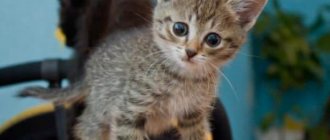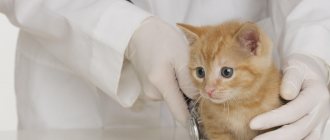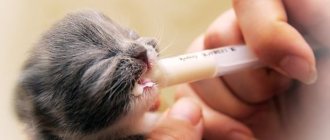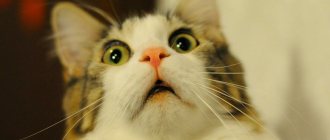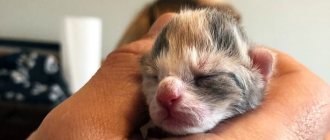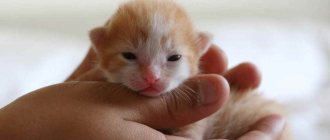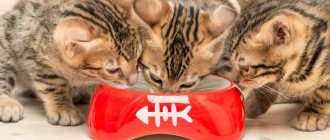Hello, dear blog readers!
If you are just getting ready to become the owner of a little furry friend, or you suddenly have a newborn baby, then this article will come in handy.
After all, taking care of the little ones is a pleasant chore and, at the same time, very responsible. The most troubling thoughts are: how to properly feed a fluffy? Especially if he is only a few days old, or maybe even hours old.
Of course, mother’s milk for babies is the key to proper development and good health; it is indispensable for the formation of strong immunity. And if there is no or little of it, is baby formula suitable for a kitten? In this case, it is necessary not only to feed, but also not to harm the cub.
Expert opinions
Veterinarians often argue, citing their observations and beliefs as evidence:
Read also: Pregnant cat
- some argue that children and kittens have different digestive systems, so what is designed for the human body should not be used for cats;
- others refer to the considerable experience of cat owners, because they have raised more than one generation of purrs. Their artificially fed kittens are practically no different in appearance from their relatives in development. They play just as happily, eat with appetite and are completely healthy, thanks to this complementary feeding.
What to feed kittens
There are only 2 options - special products for cats, infant formula, homemade food from cow's and goat's milk.
How to feed baby formula
The best option for a newborn is to buy a special mixture Beaphar Kitty-Milk, Royal Canin (Babycat Milk). Their composition takes into account the characteristics of the body of small kittens and is as close as possible to the action of mother's milk. Made in powder form. As practice shows, this option is rarely used for 2 reasons - high cost, difficulties with purchasing. The cost of a 300 g package is about 800 rubles.
Baby food
Formula milk for newborn babies is as close in composition as possible to a woman's breast milk. They are mainly made from cow's milk. To ensure that the child’s body easily absorbs nutrition, milk protein is changed and dry formulas with different degrees of preparedness are obtained:
- adapted. The most complete nutrition for babies is used from birth to 6 months;
- partially adapted.
Properties similar to breast milk, but do not contain minerals and essential fats, are suitable for children after 6 months; - low-adapted.
The composition is obtained from whole cow's milk with the addition of sucrose and starch. Give to babies after one year.
Infant formulas made with goat's milk have also recently appeared on the domestic market. This option is good for newborns who are allergic to cow products.
Question
: from birth to one year, the choice of options for infants is large, but what to choose for mustachioed suckers?
Recipes for making your own mixture
If the kitten tolerates pasteurized cow's milk well, then you can make him dishes based on it. To prepare the classic recipe you will need:
- a glass of warm milk;
- 2 chicken egg yolks;
- vegetable oil - 1 teaspoon;
- 1 drop of multivitamin solution (for example, Trivita or Tetravita).
If the kitten is very weak and thin, you can prepare a sweet mixture based on condensed milk - it contains enough fats and carbohydrates so that the baby quickly gains weight and gets stronger. It is made according to the following recipe:
- Condensed milk is mixed with water in a ratio of 1:5.
- Add bone meal at the rate of 1 teaspoon per liter of liquid.
This dish is only allowed to be given to kittens over 1 week old. Suitable only for emergency feeding (after 5–7 days you should switch to a regular formula with milk or a powder substitute).
Difficulties and errors
The main and most serious mistake is a frivolous attitude towards what and in what quantities you feed the kitten. This can lead to serious problems with his health.
Pay attention to the position in which the baby eats. If you place it on its back, the mixture may enter the lungs while eating, and this often leads to death. It happens that milk comes out of the nose and the stomach swells greatly - this means that the baby has swallowed a lot of air and is trying to burp. During feeding, be sure to ensure the correct position.
Read also: Cornish Rex: photo of the breed
If it is still acceptable to feed a kitten with a syringe at the initial stage, then experts do not recommend doing it from a spoon - such actions can lead to the fact that the sucking reflex disappears, and the baby will not be able to eat normally in the future.
What food is suitable for Scottish kittens?
Are you the proud owner of a Scottish kitten and are wondering what food is best for your pet? The fact is that for the harmonious development of a baby of any breed, the features of choosing food are the same.
Today there are many developers of food for cats. Store shelves are bursting with an abundance of products. In such conditions it is easy to get lost. But the choice of manufacturer should be taken extremely seriously. Ready-made food for Scottish kittens must be balanced and contain all useful vitamins, minerals and trace elements. To do this, before purchasing a product, you need to study its composition. The main condition for high quality feed is the meat content in it. This ingredient should be in the first place in the composition. If everything is in order with this, then we study the vitamin content.
It is recommended to choose super-premium and holistic food for Scottish kittens. Each manufacturer's product line includes products in this category, but the developers themselves are different. In any case, your cat should evaluate the food you choose. If he feels good after eating, then the product is suitable for him.
Healthy diet for a kitten
Proper nutrition ensures proper growth for kittens. When breastfeeding, they receive all the necessary vitamins and microelements. When artificially feeding with formulas, additional complementary foods must be introduced.
About 3 weeks after birth, kittens begin teething. This is when you need a supply of vitamins. Some products are starting to be introduced.
The kitten's diet consists of:
- Milk porridge made from oatmeal, rice, semolina;
- Chicken, ground beef or special meat food for kittens;
- Boiled egg;
- Cottage cheese with the addition of cream, honey, raw egg yolk;
- Meat products from the baby food series.
You can't add sugar because it disrupts metabolism. Complementary foods should be given 4 times a week.
Restrictions on use
You cannot let your pet eat only canned meat.
Veterinarians do not recommend getting carried away with canned food and formula; if the animal has problems with the gastrointestinal tract, it is better to buy special artificial milk for feeding kittens. Allergy sufferers need to carefully examine the composition. If the kitten spits out the mixture or turns away its face, then you need to choose a different food. It is impossible to feed an animal exclusively with meat mixtures, because fiber must be present in the diet.
An artificial product containing preservatives and flavor enhancers is contraindicated for animals. If you are lactose intolerant, milk slurry is also prohibited. To identify this physiological feature, you need to monitor your pet's stool after eating food. When the pet reaches the age of 35 days, it is necessary to introduce complementary foods made from natural products - cottage cheese, meat, bran and stewed vegetables, and leave the mixture as an addition to the main menu.
Feeding Basics for Newborn Kittens
The baby's body is very sensitive. It is important to follow the rules on how to feed newborn kittens without a cat, because the slightest deviation can cause digestive upset.
- Hygiene. Before feeding, wash your hands thoroughly with soap. Feeding dishes must be sterilized by boiling for 15-20 minutes.
- Temperature. Food is fed to the kitten at a certain temperature of 36-38ºC. It is best to heat in a water bath and it is highly not recommended to use a microwave oven.
- Freshness. It is better to prepare the milk mass before feeding.
- Mode. Feeding the cub must be carried out according to a schedule, day and night, otherwise the kitten may die. The norm must be followed. Overeating and undereating have negative consequences. If the kitten is full, it will fall asleep or simply stop sucking.
- Pose. Feeding should be done in the correct position so that the baby does not choke and the food is better absorbed. The correct position is lying on your stomach.
- Procedures after feeding. When the baby has eaten, give him a vertical position and hold him like that for a while. This will promote regurgitation. Next, it will be useful to massage the tummy to stimulate the act of bowel movement.
Preparing a kitten feeding kit
To feed a kitten without a cat, you need to prepare everything you need, so that later it doesn’t turn out that something necessary is missing at that very moment.
First of all, you need to purchase auxiliary devices. You will need:
- plastic pipette;
- disposable syringe with a volume of 20 ml;
- catheter;
- pacifier;
- a small bottle with a narrowed spout (for children or intended for drinking kittens);
- measuring spoon;
- convenient bowl.
It is better to take several different pipettes and nipples at once, as some may not be suitable due to poor quality or may not withstand frequent washing. Syringes should also always be in stock.
If financial resources allow, you can simply purchase a ready-made kit for feeding animals: it includes a plastic bottle with a volume of 35 or 55 ml and a silicone nipple of a suitable size for one-week and two-week-old kittens.
Hygiene procedures
In addition to nutrition, you should know other rules for caring for a newborn kitten. After eating, you can massage your cat's tummy clockwise with your fingers or the area under the tail, using a cotton pad soaked in water to empty the intestines.
Cats lick their cubs and try to keep their mouths, eyes, ears, and excretory organs clean. Wipe and wash the cat with warm and damp wipes, dry it so that it does not freeze after the procedures. Wash completely once a day in warm water.
The kitten needs a place to sleep and play at first. To begin with, a deep box is suitable, in which you need to lay soft bedding.
Cover your cat's area with old diapers or cut-up sheets so they can be easily washed or thrown away.
Kitten care
- The kitten gains weight by 10-15 grams per day; to control its weight, it must be weighed every day.
- Since the kitten's digestive system is weak, he needs help with the toilet. To do this, after each feeding, massage the kitten’s tummy and anus with a cloth or cotton wool soaked in warm water. Usually the cat always licks the kittens after eating.
- If you do everything correctly, the kitten will relieve itself 3-4 times a day.
- The stool should be light brown. If you overfeed your kitten, the stool will be yellow and runny. Gray or green diarrhea is systematic overfeeding, this leads to loss of fluid, and subsequently to the death of the kitten.
- Be sure to wipe the kitten twice a day with a damp cloth, do not forget about the face.
- Kittens should be toilet trained when they begin to eat solid food.
- Don't worry if your kitten doesn't poop for a few days. This is a very common occurrence among artificial people. If he hasn’t pooped for 4-5 days, you can give him a little Vaseline oil (1 ml 2-3 times a day). The effect will be the next day or every other day.
In what cases is milk feeding necessary?
Stories of developments can be very different and unforeseen, for example:
- the cat had a caesarean section, the first days after the operation she will not be able to feed her babies, and then everything depends on the restoration of her lactation;
- a rare exception when, for some unknown reason, a young mother refused to feed her babies;
- newborns do not have enough mother's milk, since there are more than eight of them in the litter;
- found and picked up a newborn animal;
- The fluffies have grown to 3 weeks and it’s time to introduce complementary foods.
The best and safest food for an abandoned, newborn baby is natural feeding by a cat nurse. But not all babies left without breast milk can find a lactating female. Therefore, experienced cat owners and veterinarians recommend feeding kittens with adapted formulas for children.
To feed or not to feed a kitten with infant formula?
Hello, dear blog readers!
If you are just getting ready to become the owner of a little furry friend, or you suddenly have a newborn baby, then this article will come in handy.
After all, taking care of the little ones is a pleasant chore and, at the same time, very responsible. The most troubling thoughts are: how to properly feed a fluffy? Especially if he is only a few days old, or maybe even hours old.
Of course, mother’s milk for babies is the key to proper development and good health; it is indispensable for the formation of strong immunity. And if there is no or little of it, is infant formula suitable for a kitten? In this case, it is necessary not only to feed, but also not to harm the cub.
How often should you feed
It is imperative to follow the regime and monitor the portions of the mixture. For the first two weeks, you will have to feed the kitten every 2 hours, even at night. Then the intervals are gradually shortened. After five weeks, the kitten can easily survive without food for 3-4 hours, and at night one feeding is enough for him.
At 6 weeks of age, babies feed on their own: they need to be fed up to 5 times a day and only during the daytime. Kittens grow very quickly, so the nursing period will not seem very long.
When is it recommended?
Formulas for children can be given to the following representatives of the cat family, which will benefit from a soft puree-like structure and a high concentration of minerals:
This food is suitable for older animals.
- babies from 0 to 6 months left without a mother;
- a pet weakened by illness;
- old cats with poor condition of fangs;
- pets switching from one food to another;
- cats during pregnancy and lactation.
Return to contents
How to properly feed a kitten from birth to one month
It is important not only to choose the right formula for a newborn kitten, but also to prepare it correctly and give it to the baby. You will have to weigh the animal every day - stable weight gain confirms that the “child” is receiving the right amount of nutrients. On average, he should gain 10–15 grams per day.
General feeding rules
The main requirements when feeding a kitten are sterility of dishes and freshness of food. Bottles and nipples should be washed and boiled regularly. Strict requirements are placed on food temperature. A kitten can only digest liquids between 36 and 38°C. He will simply refuse to drink a cold mixture, and a hot one will cause him harm.
It is worth remembering that a newborn does not yet understand how to eat properly. In the first weeks you need to help him:
- Place the kitten on its tummy, raising its head slightly.
- Gently, without pressing, open your mouth with two fingers, carefully insert the pacifier at an angle of 45 degrees.
When feeding, you should hold the bottle at an angle of 45 degrees. - To stimulate sucking, it is recommended to stroke the cat on the bridge of the nose, forehead or back. Do not put pressure on the throat and tummy.
It is forbidden to pour the mixture in a large stream - there is a risk that the kitten will choke.
Feeding equipment
You will need a miniature bottle and pacifier. They can be purchased at veterinary pharmacies. For example, for newborn kittens, the Hartz company produces a set - a container of optimal volume for a single meal (60 ml), a nipple 1 cm long and a tip diameter of 5 mm. This kit costs about 110 rubles.
You can buy a bottle and pacifier for feeding a kitten at a veterinary pharmacy.
You can skip the purchase of a veterinary kit and replace it with a regular glass eye dropper with a rubber tip or a syringe (without a needle). They are inexpensive (no more than 20 rubles), but since they are not designed for feeding kittens, they will be more difficult to use.
How to dilute the mixture correctly
Preparation instructions are identical for all products:
- Using a measuring spoon (it is usually included in the finished mixture), select the required amount of powder (an indication of how much dry mixture to take will be on the packaging).
- Mix the dry mixture with preheated water in a ratio of 1:2.
- Shake the bottle for a minute until the mixture becomes homogeneous and without lumps.
- Check the temperature of the finished milk by pouring a drop on your wrist. At the desired temperature of the mixture, it will not cause practically any sensations in a person (which corresponds to the temperature of his body, which is also comfortable for a kitten).
After dilution, the mixture can be stored for no more than 1–2 hours. Refrigeration to be used the next day is prohibited.
Feeding frequency
The first days of a kitten’s life are the most important and difficult. They need food every 2 hours (including at night). On average, 7–9 feeding procedures are obtained. From the age of one week, kittens are fed as follows:
- The breaks between meals are increased to 3 hours, and at night it is allowed not to feed for 5 hours.
- From three weeks of age, the permissible feeding regimen is 5–6 times a day.
- At the age of 2–5 months, kittens are fed 4 times a day.
- From 5 to 8 months - 3 times a day.
- After 8 months - 1-2 times a day, as for adult cats.
How much food should be given, weight gain norms
The dosage of the finished mixture may vary slightly (depending on the composition of the product). On average, a single serving is calculated using the formula:
- for a kitten under 2 weeks old - 25–30 ml for every 120 grams of animal weight;
- 2-3 weeks - 45-50 ml for every 120 grams of animal weight;
- over 3 weeks - 75–60 ml for every 120 grams of animal weight.
The older the kitten, the less often it is fed, but the volume of milk per feeding increases
How long will it take for a kitten to eat on its own?
Starting from the fourth week, the kitten can be weaned off milk replacer. But they do it gradually. First, you should gradually feed your baby other foods, for example, soak pieces of dry food in the mixture until it turns into a paste.
Every day you should dilute the powder more until the baby begins to consume food and water that does not contain the mixture. Veterinarians recommend completely eliminating milk substitutes by about six weeks of age.
Suitable nutrition and care
To feed kittens, choose adapted mixtures from goat or cow's milk, they are also called “from scratch”, that is, for children from birth to 1 month. The desired product should not contain sugar or additives (salt, palm oil, grains).
Please read the instructions for use first. Then dilute the powder with twice the amount of warm, clean, boiled water than is written in the recipe. Diluted food will not cause constipation and diarrhea in furbabies.
Feed your newborn kitten freshly prepared, warm milk (38 degrees) every 2 hours in small portions from a bottle with a nipple. After eating, immediately take care of the baby: massage his tummy in a clockwise circular motion, and after defecation, wipe with a damp disc around his butt.
As the animal grows, gradually increase the single serving, and from the age of three weeks, transfer the fluffy to 5-6 feedings a day.
- Constantly monitor the condition and development of the kitten. If the cub sleeps soundly, eats with appetite, has regular bowel movements and constant weight gain, then you have chosen the right milk nutrition for him.
- Observe quarantine conditions, because furry babies growing up without a mother have a weak immune system, therefore, their susceptibility to infections is increased.
How to cook properly
Cat milk replacer is a powdered milk mixture. It must be properly prepared before use.
Instructions for diluting the dry mixture can be found in the packaging with the food, but in most cases it is standard, with the exception of the ratios of the main ingredients.
To prepare the milk formula, take part of the powder needed for one feeding and dilute it with boiled water, heated to 45-50°C in the ratio indicated on the package.
The mixture is stirred vigorously so that there are no lumps left that could cause diarrhea in the baby. Additionally, the liquid can be strained through a strainer.
After the mixture is prepared, it is cooled to a temperature of 36-38°C, after which it is ready for use. The cooking and feeding process involves a number of precautions. This will keep the baby safe.
- Before preparing food, wash your hands thoroughly. Dishes must also be sterilized. Hygiene is especially important when caring for newborn kittens, whose immune systems have not yet developed.
- If possible, you should buy powdered milk for kittens in small packages. In this case, the risk of contamination with pathogenic microflora is minimal.
- The mixture left over after feeding should not be given to the baby a second time.
- It is advisable to feed kittens from a special bottle with a nipple. Some manufacturers include a bottle with a set of nipples in the milk replacer package, which are changed as the kitten grows. Feeding from a syringe or spoon is dangerous because the baby can easily choke.
Watch a very interesting video that will show you how to visually prepare formula for a kitten.
Can I give it to a cat?
Meat food for children, including individual pieces, can be given to a kitten no earlier than the 30th day of life.
Semolina is an undesirable product for such animals.
Veterinarians allow kittens to be fed infant formula made with milk that does not contain sucrose, fructose, as well as honey, fruits and cereals. Garlic, onions and peppers, which destroy red blood cells, are contraindicated as seasonings. Preference should be given to food with the engraving “0+” rather than to products for children 2 and 3 years old, since the latter contain additives and salt that are poorly digestible for animals. The mixtures should contain a minimum content of starch, which is rich in mashed potatoes and glucose syrup, because the white powder is not digested by the animal’s intestines. Semolina is also excluded, because it provokes indigestion, vomiting and diarrhea. It is especially undesirable to give mixtures with semolina porridge to which cream has been added.
When preparing the mixture, you need to use 2 times more liquid than the manufacturer indicates. Increasing the volume of water is necessary so as not to overfeed the kitten. The composition of baby gruel contains excess amounts of fats and minerals for the body of a newborn cat. If for a grown animal the mixture is a rare delicacy that complements canned food and dry food, then it is better to choose meat puree without vegetables and berries that are exotic for your pet. Only fresh formula, prepared less than a day ago, is suitable for feeding. It is best to feed kittens “Agusha” or “Tema”.
Selection of cookware
An inexperienced person can make serious mistakes when feeding a four-legged orphan. When offering your pet a commercial formula, it is not advisable to use a bottle intended for infants. The ideal option is a bottle from a pet store. It is possible to use a children's accessory provided that the hole is tiny. Before offering the animal a treat, lower the bottle with the nipple down and apply light pressure. A white substance should slowly drip from the hole. If it pours out before pressing on the bottle, the hole is wider than necessary. Using such “treacherous” utensils is risky. Otherwise, the little kitten is in danger of choking.
Some breeders use a pipette to feed their pets. Take the risk of following their example. Sometimes housewives inject liquid into the animal's mouth using a syringe.
To protect the kitten from intestinal infection, the owner must wash the pacifier after each feeding, then pour boiling water over it.
An “infant” diet is relevant for an animal in the first weeks of life. At 2 months, a stronger pet is allowed to give beef, chicken, low-fat cottage cheese, and boiled vegetables.
Feeding technique
- You can feed a kitten using a pipette, a syringe (without a needle), a catheter (at the end of the catheter there are holes through which the milk mixture flows, a syringe is put on the other end), a drop bottle with a narrow spout (rinse thoroughly beforehand), or you can Buy a special bottle with a pacifier for kittens at the pet store.
- The kitten should be fed so that it lies on its belly, otherwise it may choke.
- Control the supply of milk mixture, do not use wide openings, this may lead to liquid entering the respiratory tract.
- You can only help the kitten introduce the milk itself, but you cannot, so that it does not lose its sucking reflex.
- The bottle should be held at a 45 degree angle, not horizontally.
- A one-week-old kitten should be fed every 2 hours, in the second week every 3-4 hours, and in the third week 5-7 times.
- The kitten should receive about 5-6 ml per feeding. In the second week, double the norm. In the third week - twice more. The dose can be easily measured using a syringe.
- It takes about 5 minutes for a kitten to eat.
- A sign of satiety is that the kitten sucks sluggishly and begins to fall asleep.
- If the kitten cannot eat as much as you give him in one feeding, then increase the number of feedings. Don't force your kitten to eat.
- After feeding, gently stroke the kitten's tummy, this is necessary so that he burps and air bubbles come out of the esophagus.
- When artificially feeding kittens, they are deprived of the immunity received from mother's milk, so it is necessary to maintain the sterility of equipment and the cleanliness of the room. There should be no drafts.
Reviews about caring for kittens without a cat
As far as I know, kittens cannot survive on mixtures alone. A friend feeds formula + goat's milk, another only feeds goat's milk + quail eggs, both nurse stray, weak newborn kittens from time to time. As a rule, babies die on some mixtures. Both friends have produced more than one litter of kittens from scratch, some were found simply in a box in the entrance, others in bags in a trash can. In general, they fed successfully and safely
Gia
https://www.zoovet.ru/forum/?tid=35&tem=660158
In our entrance, a cat somehow lambed and disappeared... apparently she was hit by a car... I picked up her Siamese kitten and fed her baby formula, first through a pipette and a syringe, he lay with me with a heating pad (45 degrees) when he fed his stomach on a heating pad, massage and pooped he. The navel fell off on the 7th day, and after 2 weeks the eyes began to open! A month later he was already crawling and then started running!!! I love him very much, I named him son!!! He loves me very much!!! Now he is 3 years old!!!
Oksana
https://www.baby.ru/community/view/920867/forum/post/29600157
If a cat is left without a mother, its survival is entirely dependent on the person. The animal needs warmth, hygienic care, protection from danger and, of course, constant feeding. If difficulties arise in the process (for example, the baby categorically refuses to eat or weight gain is too slow), you should contact a specialist. The veterinarian will examine the animal and tell you what specific care features the newborn requires.
for feeding a newborn kitten on small kittens newborn kittens feeding kittens newborn kittens feeding kittens finishing feeding kittens which newborn kittens newborn kittens newborn kittens without
BreedsArticleDogNoContents


